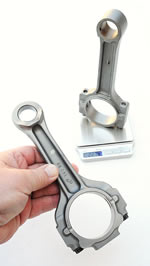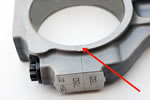Ruthless Pursuit of Power: The Mystique of the C6 Corvette LS7 Engine - Page 6 of 26
Ruthless Pursuit of Power: Lucky Seven Edition: The Mystique of the 7-Liter, 7000-RPM, LS7 - Page 6 of 26
 |
 |
by Hib Halverson
© May 2013— Updated: November 2014
No use without permission, All Rights Reserved
Featherweight Engine Artwork
Part of the LS7's mystique is its use of titanium. Its connecting rods and intake valves are a rare application of that lightweight material in a production engine.
Titanium is a silver-gray in color and the ninth most abundant metal. It's often found in mineral deposits and small amounts are in most living things. Number 22, on the periodic table, engineers often refer to it by its chemical abbreviation "Ti" (pronounced "tie"). Titanium's density is somewhere between that of aluminum and stainless steel. As strong as some steels, but 45% lighter, It has the highest strength-to-mass ratio of any metal. Its other noted property is excellent resistance to corrosion. It is slow to react with water and air because it forms its own, oxide coating which protects it from further reaction. Ti is fairly hard, non-magnetic and does not conduct heat or electricity very well. Interestingly, besides aerospace, military and industrial applications--and LS7 engine parts--titanium is a popular metal for jewelry. Before I got married, my then-fiancee asked me what kind of wedding ring I wanted. "Titanium--because of its strength-to-mass ratio my dear."
Making Ti engine parts isn't easy. While the metal is abundant, it rarely occurs in pure form. Typically, it's produced using the "Kroll Process", a complicated and quite costly pyrometallurgical procedure. In a series of high-temperature chemical reactions, raw titanium "sponge" is extracted from the mineral rutile. Next, Ti sponge is melted into ingots. Since titanium ignites before its melting point is reached, this is done in a vacuum or an inert atmosphere--other than nitrogen, of course, because Ti is one of the few elements which burns in pure nitrogen. The Vacuum Arc Remelt (VAR) process produces titanium ingots which are rolled into flat or bar stock then forged into LS7 rods and intake valves. Machining titanium can be difficult, because it galls or softens if improper tooling or inadequate cooling is used, i.e.: if you screw-up the machining process, a lot of expensive raw material ends up scrap. How expensive? At this writing, titanium ingots run about $10.30 a pound. For comparison, aluminum was about 93 cents a pound and benchmark, cold-rolled steel was about 37 cents a pound.
The LS7's forged titanium con rod is a work-of-art in many ways. Visually, it's so pretty that, if they weren't so expensive, we engine wonks would buy them as intriguing Christmas tree ornaments, attention-getting paper weights, unusual props for jugglers or for "industrial-chic" themed interior decorating. Ok, seriously--the Ti connecting rod is pretty because of the silvery-gold-colored, chrome-nitride coating typical of titanium engine parts. It's, also, a work of "engine-development-art" as it took a lot of computer analysis and engine testing to get it to where it could be reliable and durable to the standards GM has for all production engines.
Why a Ti rod? Not for the reasons most might think. Indeed, substituting forged titanium for forged steel significantly reduces mass allowing the rotating assembly to accelerate quicker improving the engine's response and reducing parasitic losses as the engine speed accelerates, however, titanium LS7 rods are more a durability measure than a performance enhancement.
On the power stroke, when the piston and rod assembly reach the bottom of their travel, inertia combined with what's left of combustion pressure apply a great deal of load on the oil film between the upper bearing shell and the crankshaft journal. During LS7 computer modeling, the Small-Block team discovered that with the, Group III, 5W30 synthetic engine oil used in Corvette engines, connecting rod bearing oil film strength would be unacceptable when the engine was under the heaviest load and at high RPM. Further, they decided a titanium rod would provide the mass reduction necessary to decrease those inertia loads such they would not exceed the film strength of the oil.
"During development of the 6.4-liter, we didn't use a ti con rod," John Rydzewski said. "It was an investment-cast (steel) con rod. It had a lot of mass lightener pockets--less material (than a forged LS6 rod) to keep the mass down. However, with the seven-liter, the longer stroke and higher engine RPM was a concern for proper oil film thickness.
"Our analysis capability is really good for oil film thickness. This analysis comprehends engine speeds, loads, temperature, mass/inertia and geometry. At high speed, you have a lot of inertia, a lot of reciprocating mass which will reduce oil film thickness. We had to make a big move to increase the film thickness robustness. That (a titanium rod) was the most straight forward way to do it."
That begs the question: rather than an expensive set of Ti rods, why not just a better engine oil? You can buy a lot of premium, ester-based synthetic oil, which has better film-strength properties, for the cost of those rods.
Well--it's just not that simple. To use forged steel rods and a higher film-strength oil, General Motors would, first, have to admit that fabled Mobil 1 5W30 and its "Dexos 1" successor, were inadequate for use in the LS7. That was sooooo not-gonna-happen. Plus--while it is true that there are engine oil products with better film strength properties than the factory-fill 5W30 used in LS7s; when we asked John Rydzewski about that, he commented, "A higher weight oil can improve film thickness, but that, alone, would not have met the design requirements." So, the LS7 has those bitchin' Ti rods, with their durability advantages and the better throttle response they provide, to add to its mystique.
Rydzewski continued, "Titanium rods are good for reducing reciprocating mass but their downsides are: they are expensive, (Note: we couldn't get cost numbers from GM but, according to our local Chevy dealer's Parts Department, a replacement LS7 titanium rod is nearly four times the price of a steel, LS3 rod). They take a lot of machining steps. They come from Mahle in Germany, so there is a long lead-time. The process--forging, a lot of machining and application of the (chromium nitride) coating--is complicated. There are few suppliers out there which can do titanium rods for production applications.
"We've had pretty good luck with them. We've never broken a rod because of the strength. An unusual property of a titanium rod (compared to a steel rod) is its different modulus of elasticity. They bend a little bit differently and that concerned us at first. Because of the different modulus of Ti, the stiffness requirements had to be comprehended in the design. Many sections of the Ti rod were larger than required for a con rod made of conventional (forged steel).
"Also, we had issues with 'Ti dust wear' during our first round of builds. And then we started seeing some signs later on, once we got into parts that came off manufacturing equipment. The two rods (on the same crankshaft journal) rub against each other. Titanium on titanium does not wear well. If you have sharp corners, particles can break off. They get between the rods and start wearing away the coating and get you into trouble."
Ti dust forced implementation of special manufacturing procedures at Mahle. At the part line, between the rod and cap, there can be slight misalignment resulting in a sharp edge which can abrade the adjacent rod. The ti dust problem was traced to that area. Besides Ti dust control, during the LS7 development, other procedures were introduced to avoid impact damage to the rod which causes stress risers and damages the coating. The initial round of special procedures were put in place at Mahle before the start of production.
Sometime after production began in mid-2005, additional durability testing and development work being done on the LS9, the second GM engine to use titanium connecting rods, indicated further "anti-Ti-dust" measures were necessary. As a result, small grooves were added on the sides of the rod's big end right at the parting line between the rod and the rod cap. This proved a better way to address any sharp edges which might cause a Ti dust issue.
 |
 |




